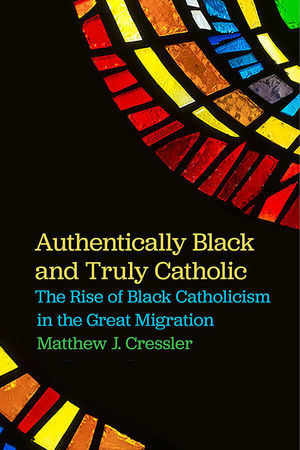When I left Notre Dame Magazine last year to start journalism school at Northwestern, I assumed that my days writing about Catholicism were numbered. My first ethics class of the fall quarter was canceled so the professor could celebrate Rosh Hashanah; in another class, one early assignment was to read Cosmo cover to cover. In this multicultural environment, I didn’t anticipate covering the Catholic beat — but as I’ve heard Anne Thompson ’79 say, “If you’re a journalist who went to Notre Dame, you’re eventually going to cover religion.”
“Eventually” came quickly at Medill, when in the second week of my Methods of Reporting class I was assigned to write about faith in Chicago, with a focus on the South Side neighborhood of Bronzeville.

I researched and read up, hoping to find a synagogue or mosque with which to expand my religion-reporting horizons. Instead, I found Augustus Tolton.
Father Tolton was the first African-American priest ever ordained, and he established his first parish in Bronzeville. Given his elevation to venerable last summer, he is considered by many likely to become the first African-American to reach sainthood — making his canonization cause and his legacy too big a Bronzeville story to ignore. I dove into research on the black Catholic community of the South Side, and along the way, I discovered Matthew Cressler.
A historian of black Catholicism, Cressler completed his doctoral degree at Northwestern, work that led to the publication of his first book, Authentically Black and Truly Catholic: The Rise of Black Catholicism in the Great Migration. A Notre Dame friend recommended the book to me when I mentioned my Tolton project, so I checked it out from the Evanston campus library.
I’ll be honest: I didn’t think I would like it. I knew the book, like Cressler himself, would be a useful source— it uses Chicago as a case study for African-American Catholicism as a whole, and it devotes whole chapters to the parishes I was reporting on in Bronzeville. But as a nonacademic, I figured I would find this academic text dry.
I figured wrong.
Over 200 engaging pages, Authentically Black and Truly Catholic lays out a history of black Catholicism in Chicago, from the convert-making white priests who saw the South Side as “foreign mission” territory to the revolutionary Catholics of the 1970s who held Black Power Masses and hid asylum-seeking Black Panthers in their sacristies. It was made especially interesting to me by my research, but it would make a good read for anyone with an interest in black or Catholic history — perhaps especially for those who forget that those histories are intertwined.
It’s no secret that African-American Catholics are a fairly small group. According to the Pew Religious Landscape Study, just 3 percent of American Catholics identify as black, and just 5 percent of African-Americans identify as Catholic. Early in his book, though, Cressler asserts that these little numbers mask big significance. There are more African-American Catholics, he points out, than members of the African Methodist Episcopal church. And when you expand the term to include Afro-Latinos, the majority of “black Christians” in the Americas are, in fact, Catholic.
In one Bronzeville church, the parish historian gave me an emotional tour of its legacy of racial change. He pointed out the white faces memorialized in the stained-glass windows and explained that the parish had once been majority Irish. The white parishioners fled to the suburbs when the Great Migration brought African-Americans into the neighborhood, he said, and the archdiocese closed the parish, claiming that there were no Catholics left in the area. The black Catholics of the neighborhood had to fight to get the church reopened, he explained, and it became one of the largest African-American parishes in the United States.
I expected Cressler’s book to explore such tensions and to examine the racial justice preached by the kind of black Catholics who marched at Selma. It does, but it also points out the belief of early black Catholics — Tolton included — that the Church was a ticket to a heavenly future that would transcend race altogether. It explores as well the tensions of midcentury black Chicagoans who converted to Catholicism in order to practice a more “genteel” Christianity than their neighbors in more rambunctious Protestant churches.
Essentially, Cressler problematizes the idea that there’s any one way to be black and Catholic — a crucial viewpoint for any consideration of a minority group.
My one complaint about Authentically Black and Truly Catholic is that its author, like me, is white. I felt some unease learning about African-American Catholicism from someone who has never experienced the identity himself, just as I sensed something odd about those black parishes in Chicago that, even today, are staffed by white priests. Clearly, though, I understand Cressler’s impulse to tell the stories that he does — with my work in Bronzeville, I was in a nearly identical spot. The best that any white scholar of black lives can hope for is to be a good ally, and in his consistent elevation of black voices and the nuanced view he presents of black Catholic experience, Cressler seems to hit that mark.
“If we hope to understand what it means to be Black and religious — or, to put it more simply, what it means to be human,” he writes, “we need to be willing to wrestle with the contradictions and complexities of life as it is lived.”
Authentically Black and Truly Catholic wrestles expertly with these issues, and I hope that in my work on Tolton and his legacy, I will manage some semblance of the same. For others who wish to grapple with the complex, contradictory and fascinating history of one slice of our increasingly diverse Church, this book is a great place to start.
Sarah Cahalan is a former associate editor of this magazine.